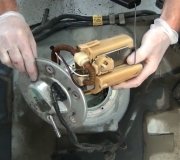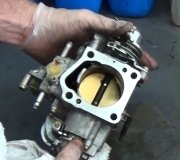Don't drill your own hole in the exhaust. The test involves drilling just a tiny 1/8" hole, then the probe of the back pressure gauge is inserted to measure back pressure. That is one test to ask for. To do something similar yourself would require unbolting the exhaust pipe from the exhaust manifold, (if the bolts aren't rusty and ready to snap off), then roaring down the highway to see if performance improves. There might be an improvement if you remove the oxygen sensor. The 3/4" hole will relieve some back pressure, and that might make enough difference to be noticeable.
The next test is called a "cylinder leakage test". It takes a lot longer than a compression test, but is much more informative. One at a time, each piston is brought to top dead center, then compressed air, regulated through the tester, is introduced through the spark plug hole. The mechanical condition of the engine is assessed by observing the percent of leakage and where the air leaks out. Hissing at the tail pipe means the exhaust valve is leaking. Hissing at the oil fill cap or dipstick tube indicates leaking piston rings. Bubbling in the radiator indicates a cracked head, or more commonly, a leaking head gasket. The more likely suspect here would be a leaking intake valve. That would show up as hissing through the throttle body assembly.
Those two tests would identify exhaust gas that is getting into the intake system, either from leakage or pressure. The third test would identify the fuel / air mixture being fired at the wrong time, when the intake valve might still be partially open. That involves watching the spark lines on an engine analyzer. There should be one nice spike for each cylinder when a spark plug fires. If that's the case, but they move around a lot, that would cause erratic ignition timing. The most typical cause of that is worn distributor shaft bushings, but that was more common in Dakotas. Also, it tended to cause surging, not back firing. Of more interest would be any additional, possibly smaller spikes between the regular firing pulses. Those would indicate a stray signal is triggering the Engine Computer to fire the ignition coil extra times. If a spark plug fires when the intake valve is still open, you will hear and feel the back fire. The sensors that deliver the trigger pulses at the exact moment are magnetically operated. Some type of trigger wheel disturbs the magnetic field around the sensor causing the signal voltage to be developed. Anything else that causes a similar signal to occur in that wire will be interpreted by the computer as a trigger pulse, and it will fire the ignition coil. A cracked sensor core results in two smaller, weaker magnets. It still might be able to make a big enough signal for the engine to run, but vibration between the two pieces of the core can generate false extra pulses. Extra pulses can also be "induced" magnetically in the signal wire by "RFI". That's radio frequency interference. When current flows through a wire, a magnetic field is set up around that wire. That is how electromagnets work. When a wire is placed in a magnetic field, it causes a voltage to be developed in that wire. Voltage pulses introduced that way can produce extra triggering pulses to the computer. The most common cause of this is misrouted spark plug wires. They have real high current flow for just a fraction of a second when the spark plug fires. That results in a real high magnetic field that can induce spikes in other wires. (That magnetic field is how inductive-pickup timing lights are triggered). To prevent these stray signals, wire harnesses are specifically routed away from spark plug wires and other sources of magnetic interference. Many engines use metal sleeves over the spark plug wire boots to contain the magnetic field. If extra pulses are seen on the engine analyzer firing the ignition coil, the next step would be to use an oscilloscope function to view the signals coming to the computer to see if stray, extra signals are causing the problem.
Another clue might be gained by momentarily shorting one spark plug wire to ground while the engine is running. If one cylinder always eliminates the back firing, suspect a valve problem or something else related to that single cylinder. To see if just that one plug wire is inducing a pulse into another wire, it must be grounded at the distributor. If it is grounded at the spark plug, current will still flow through it to your ground and the magnetic pulse will still be developed. If there is no significant change when any one plug wire is grounded, the cause of the back firing is related to something all of the cylinders have in common, such as the plugged exhaust.
If the spark lines appear steady and correct on the engine analyzer, a different approach would be to temporarily forget about the back firing. Treat it as a secondary symptom and concentrate on the bogging and low power. Besides the fact the bad stuff must be able to be freely pushed through the exhaust system, the good stuff must be made up of the proper ratio of fuel and air, and it must be burned at the proper time. An incorrect amount of fuel or air to one cylinder only will result in a misfire you can feel but the rest of the cylinders will provide plenty of power. When hesitation or bogging down are involved, all the cylinders are responsible. They are all not getting enough fuel or enough air. With two injectors instead of one for each cylinder, a partially plugged injector will result in an excessively lean mixture to half of the cylinders. Since there isn't much in the way of incoming air, a fuel problem is more likely. Now the question becomes whether the injectors aren't delivering as much fuel as the computer is requesting, or if the computer isn't requesting enough fuel in response to incorrect sensor data. This is where the experience of a driveability mechanic comes in. When a sensor sends an obviously wrong signal, the computer detects it, sets a diagnostic code in memory, and turns on the Check Engine light. When the sensor's signal is within the realm of possibility, but it doesn't agree with other sensors or the operating characteristics of the engine, a different fault code could be set. An example would be the MAP sensor indicating a real heavy load on the engine while the throttle position sensor says we're at idle. The third type of sensor failure involves a believable but incorrect value. These are the ones that don't trigger a fault code so the mechanic has to evaluate what the Engine Computer is seeing and determine if those readings are correct or are causing the problem.
So there's a bunch of ideas. All major cities have specialty shops that concentrate on these types of problems. They might be less expensive in the long run if they are already familiar with looking for these things. If you are near Jolliet, IL, I can find the name of one such shop. One of the fellows there is a Carquest trainer who travels to a few different states to put on relatively high-level classes. They have come up with some really unusual causes of problems and many unique ways to quickly find them.
Please forgive me when I take so long to reply. My Verizon e-mail is going through major changes and they are out-of-service about 20 hours per day for the last couple of weeks. Normally I receive an automated message when you post a followup response. Now I might not see that message for many hours, and the direct link to it doesn't work either.
Caradiodoc
Saturday, April 10th, 2010 AT 1:26 PM


